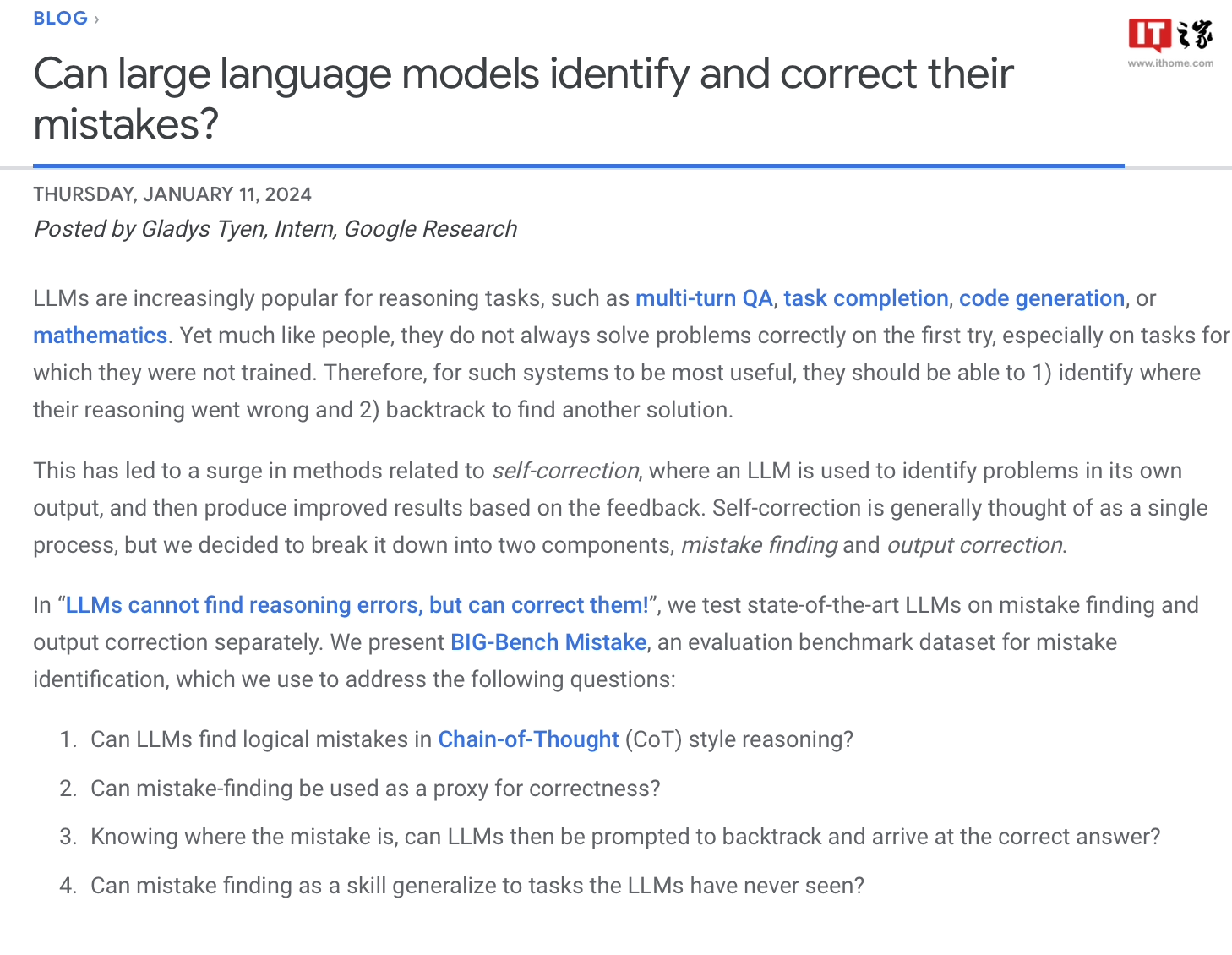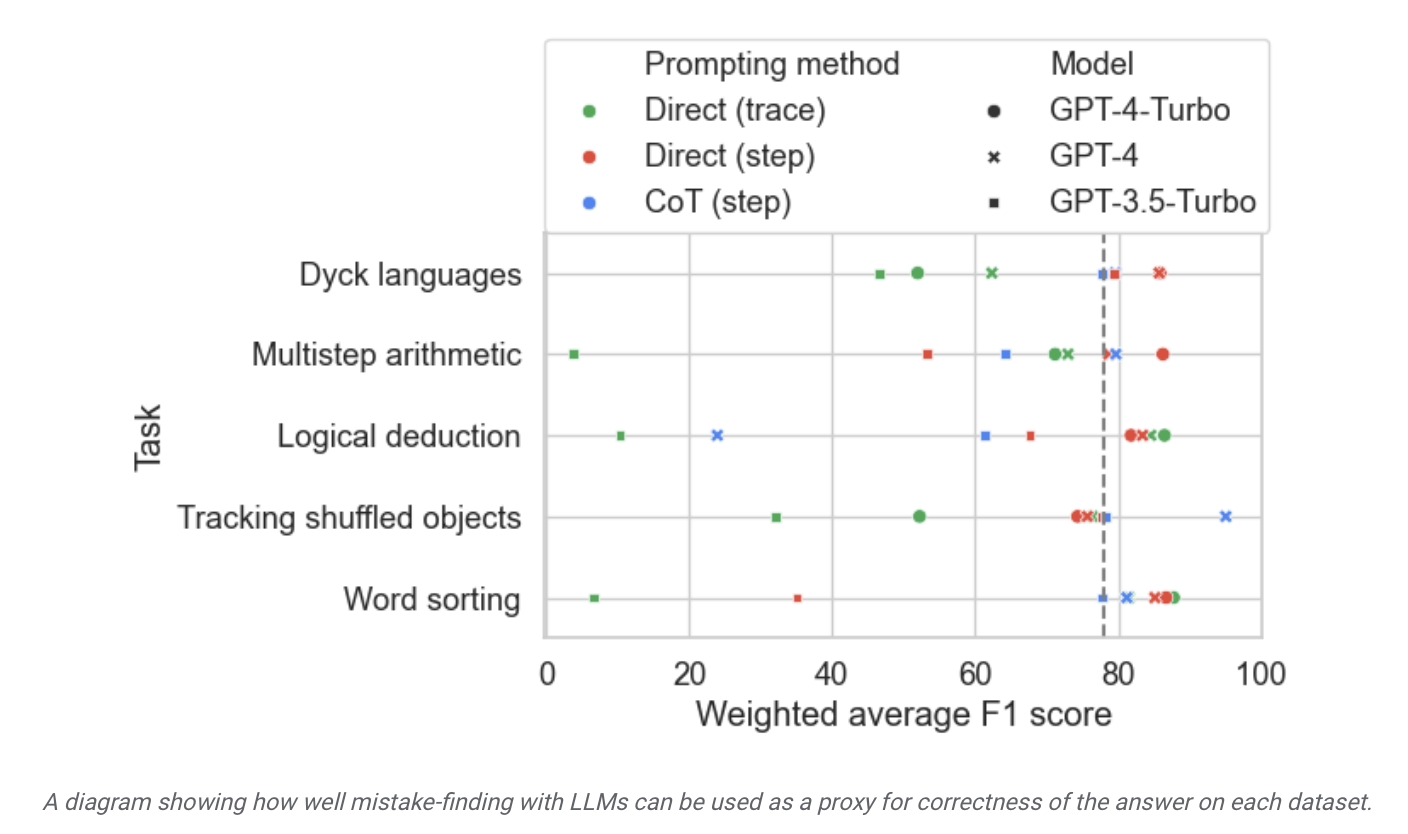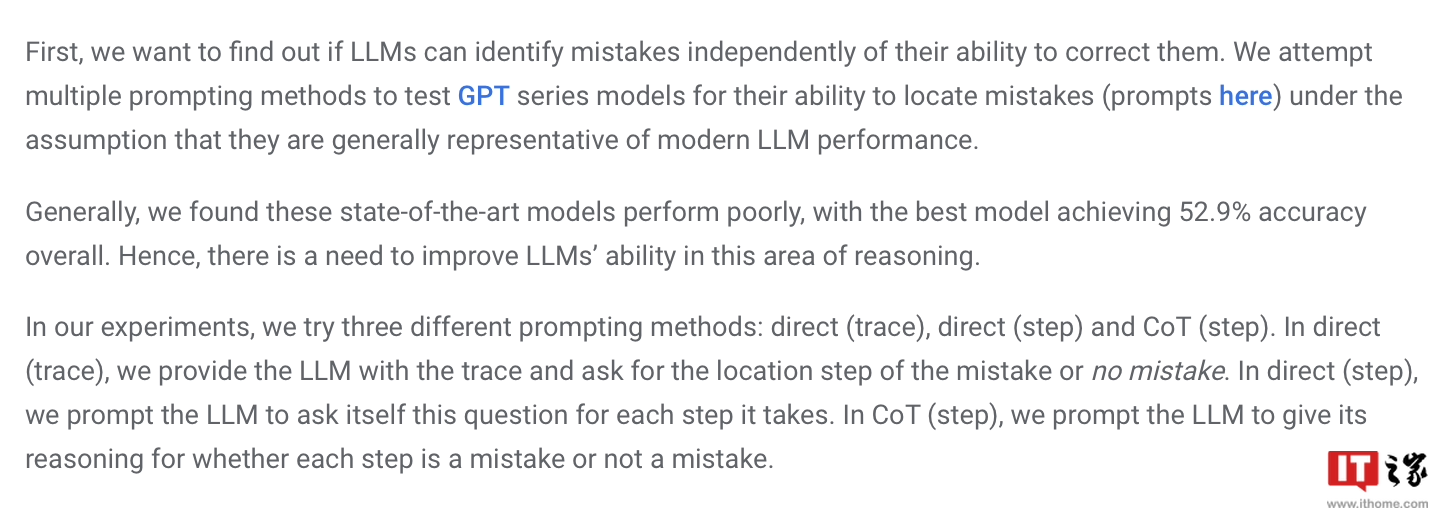 Technology peripherals
Technology peripherals
 AI
AI
 Google releases BIG-Bench Mistake dataset to help AI language models improve self-correction capabilities
Google releases BIG-Bench Mistake dataset to help AI language models improve self-correction capabilities
Google releases BIG-Bench Mistake dataset to help AI language models improve self-correction capabilities

Google Research used its own BIG-Bench benchmark to establish the "BIG-Bench Mistake" data set and evaluate the error probability and error correction capabilities of popular language models on the market. Research. This initiative aims to improve the quality and accuracy of language models and provide better support for applications in the fields of intelligent search and natural language processing.

Google researchers said they created a special dataset called "BIG-Bench Mistake" to evaluate the error probability and self-correction of large language models ability. The purpose of this dataset is to fill the gap in the past lack of datasets to assess these capabilities.
The researchers ran 5 tasks on the BIG-Bench benchmark using the PaLM language model. Subsequently, they modified the generated "Chain-of-Thought" trajectory, added a "logical error" part, and used the model again to determine errors in the chain-of-thought trajectory.
In order to improve the accuracy of the data set, Google researchers repeated the above process and formed a dedicated benchmark data set called "BIG-Bench Mistake", which contained 255 logical errors.
The researchers pointed out that the logical errors in the "BIG-Bench Mistake" data set are very obvious, so it can be used as a good testing standard to help the language model start practicing from simple logical errors and gradually improve the ability to identify errors. ability.
The researchers used this data set to test models on the market and found that although the vast majority of language models can identify logical errors that occur during the reasoning process and correct themselves, this process "is not sufficient." Ideal" , often requiring human intervention to correct what the model outputs.

.
 Google researchers also claimed that this BIG-Bench Mistake data set will help improve the model’s self-correction ability. After fine-tuning the model on relevant test tasks, “even Small models also generally perform better than large models with zero-sample cues."
Google researchers also claimed that this BIG-Bench Mistake data set will help improve the model’s self-correction ability. After fine-tuning the model on relevant test tasks, “even Small models also generally perform better than large models with zero-sample cues."
Accordingly, Google believes that in terms of model error correction, proprietary small models can be used to "supervise" large models. Instead of letting large language models learn to "correct self-errors",
deployment is dedicated to supervising large models. Small, specialized models of models help improve efficiency, reduce associated AI deployment costs, and make fine-tuning easier.The above is the detailed content of Google releases BIG-Bench Mistake dataset to help AI language models improve self-correction capabilities. For more information, please follow other related articles on the PHP Chinese website!

Hot AI Tools

Undresser.AI Undress
AI-powered app for creating realistic nude photos

AI Clothes Remover
Online AI tool for removing clothes from photos.

Undress AI Tool
Undress images for free

Clothoff.io
AI clothes remover

Video Face Swap
Swap faces in any video effortlessly with our completely free AI face swap tool!

Hot Article

Hot Tools

Notepad++7.3.1
Easy-to-use and free code editor

SublimeText3 Chinese version
Chinese version, very easy to use

Zend Studio 13.0.1
Powerful PHP integrated development environment

Dreamweaver CS6
Visual web development tools

SublimeText3 Mac version
God-level code editing software (SublimeText3)

Hot Topics
 1386
1386
 52
52
 How to solve the complexity of WordPress installation and update using Composer
Apr 17, 2025 pm 10:54 PM
How to solve the complexity of WordPress installation and update using Composer
Apr 17, 2025 pm 10:54 PM
When managing WordPress websites, you often encounter complex operations such as installation, update, and multi-site conversion. These operations are not only time-consuming, but also prone to errors, causing the website to be paralyzed. Combining the WP-CLI core command with Composer can greatly simplify these tasks, improve efficiency and reliability. This article will introduce how to use Composer to solve these problems and improve the convenience of WordPress management.
 How to solve SQL parsing problem? Use greenlion/php-sql-parser!
Apr 17, 2025 pm 09:15 PM
How to solve SQL parsing problem? Use greenlion/php-sql-parser!
Apr 17, 2025 pm 09:15 PM
When developing a project that requires parsing SQL statements, I encountered a tricky problem: how to efficiently parse MySQL's SQL statements and extract the key information. After trying many methods, I found that the greenlion/php-sql-parser library can perfectly solve my needs.
 How to solve complex BelongsToThrough relationship problem in Laravel? Use Composer!
Apr 17, 2025 pm 09:54 PM
How to solve complex BelongsToThrough relationship problem in Laravel? Use Composer!
Apr 17, 2025 pm 09:54 PM
In Laravel development, dealing with complex model relationships has always been a challenge, especially when it comes to multi-level BelongsToThrough relationships. Recently, I encountered this problem in a project dealing with a multi-level model relationship, where traditional HasManyThrough relationships fail to meet the needs, resulting in data queries becoming complex and inefficient. After some exploration, I found the library staudenmeir/belongs-to-through, which easily installed and solved my troubles through Composer.
 How to solve the complex problem of PHP geodata processing? Use Composer and GeoPHP!
Apr 17, 2025 pm 08:30 PM
How to solve the complex problem of PHP geodata processing? Use Composer and GeoPHP!
Apr 17, 2025 pm 08:30 PM
When developing a Geographic Information System (GIS), I encountered a difficult problem: how to efficiently handle various geographic data formats such as WKT, WKB, GeoJSON, etc. in PHP. I've tried multiple methods, but none of them can effectively solve the conversion and operational issues between these formats. Finally, I found the GeoPHP library, which easily integrates through Composer, and it completely solved my troubles.
 How to solve the problem of PHP project code coverage reporting? Using php-coveralls is OK!
Apr 17, 2025 pm 08:03 PM
How to solve the problem of PHP project code coverage reporting? Using php-coveralls is OK!
Apr 17, 2025 pm 08:03 PM
When developing PHP projects, ensuring code coverage is an important part of ensuring code quality. However, when I was using TravisCI for continuous integration, I encountered a problem: the test coverage report was not uploaded to the Coveralls platform, resulting in the inability to monitor and improve code coverage. After some exploration, I found the tool php-coveralls, which not only solved my problem, but also greatly simplified the configuration process.
 git software installation tutorial
Apr 17, 2025 pm 12:06 PM
git software installation tutorial
Apr 17, 2025 pm 12:06 PM
Git Software Installation Guide: Visit the official Git website to download the installer for Windows, MacOS, or Linux. Run the installer and follow the prompts. Configure Git: Set username, email, and select a text editor. For Windows users, configure the Git Bash environment.
 Solve CSS prefix problem using Composer: Practice of padaliyajay/php-autoprefixer library
Apr 17, 2025 pm 11:27 PM
Solve CSS prefix problem using Composer: Practice of padaliyajay/php-autoprefixer library
Apr 17, 2025 pm 11:27 PM
I'm having a tricky problem when developing a front-end project: I need to manually add a browser prefix to the CSS properties to ensure compatibility. This is not only time consuming, but also error-prone. After some exploration, I discovered the padaliyajay/php-autoprefixer library, which easily solved my troubles with Composer.
 How to solve the problem of virtual columns in Laravel model? Use stancl/virtualcolumn!
Apr 17, 2025 pm 09:48 PM
How to solve the problem of virtual columns in Laravel model? Use stancl/virtualcolumn!
Apr 17, 2025 pm 09:48 PM
During Laravel development, it is often necessary to add virtual columns to the model to handle complex data logic. However, adding virtual columns directly into the model can lead to complexity of database migration and maintenance. After I encountered this problem in my project, I successfully solved this problem by using the stancl/virtualcolumn library. This library not only simplifies the management of virtual columns, but also improves the maintainability and efficiency of the code.



